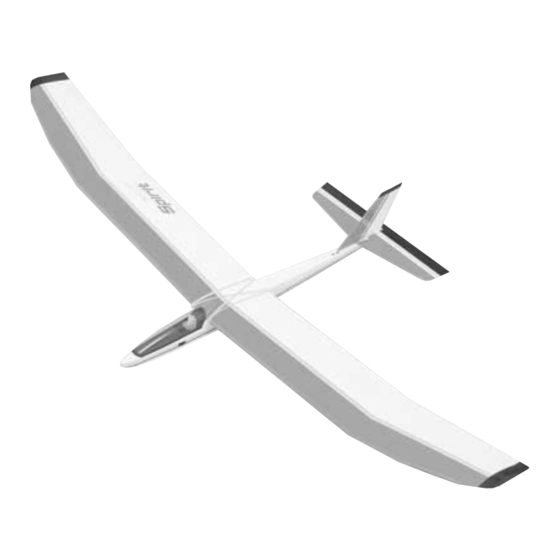GREAT PLANES Spirit Manuale di istruzioni - Pagina 16
Sfoglia online o scarica il pdf Manuale di istruzioni per Giocattolo GREAT PLANES Spirit. GREAT PLANES Spirit 16. 2-meter sailpane

you where the center is. These "Masters of the Sky" will
often fly right along with sailplanes.
Practice Those Landings! – Most thermal contests are
won or lost during the landing. Establish a particular landing
pattern and try to stick to it for all landings. Learn to shift
your pattern to account for the wind and particular flying field
characteristics. Spoilers can be very useful during contest
landings. They allow you to bring the sailplane in for a
landing higher or faster than normal to guard against any
last minute sink or gusts and dump the extra altitude and
speed at the last second. They can also be used to help
control your skid. Opening the spoilers will stop the plane
from sliding a little quicker. You can also "steer" the plane
while it is sliding along the ground. Don't expect to be able
to "horse it around" but you can gain valuable inches by
using the rudder to guide it toward the spot as it slides to a
stop. Be very careful not to "ground loop" the plane since
you will lose your landing points if the plane flips over.
Concentrate – Keep your eye on your sailplane during your
contest flights. Have a helper or your counter watch the
other sailplanes in the air. Sometimes your sailplane will
wiggle so quickly or gently that you may miss it if you are not
paying close attention. If you find a productive thermal, don't
leave it because your helper tells you that someone else has
found a different one.
Know Your Sailplane! – Learn what your sailplane will and
won't do and fly within this envelope. This will allow you to
ride thermals downwind while knowing when you have to
head back to make your landing safely.
Learn From The Wind! – Keep track of which way the wind
is blowing. If the wind suddenly shifts, there is some thermal
action fairly close to you. The air is probably being either
sucked up into a thermal or falling out of some sink. In either
case it is often a good idea to fly in the direction the wind is
blowing if your sailplane is in the general area. This will take
you towards a thermal if there is one or away from the sink,
both of which are desirable.
SLOPE SOARING
Slope soaring is a type of flying that is very popular in hilly
regions and along the coasts. This type of soaring is
possible when the wind is blowing directly up a hill or cliff. As
the wind hits the slope it is forced up, producing lift which
can be utilized by real sailplanes, hang gliders, birds and
even model sailplanes.
To be able to slope soar, you need a slope with a smooth
piece of land (or water) out in front of it and a breeze blowing
pretty close to straight up the slope. The higher and steeper
the hill or cliff the better. Also the larger and smoother the
land out in front the better. The air flowing along hits the hill,
is forced up and can generate a very large area of lift.
Behind the hill is a large area of turbulent air that can be
very dangerous to try to fly in. The faster the wind is blowing,
the stronger the lift and turbulence will be.
Flying
To fly off a slope, stand near the edge and throw the
sailplane (nose down) into the wind. As the sailplane flies
out into the "band" of lift it will begin to gain altitude. Turn
and fly parallel to the slope and make all of your turns into
the wind (especially when you are close to the slope). You
will be surprised at the altitude you can gain just from slope
lift. Thermals will often be "popped loose" by these slopes. If
you catch a thermal and follow it downwind, be very careful
to stay high enough to make it back to the slope without
flying through the turbulent air behind the slope. If you don't
have enough altitude you may want to land a good distance
behind the slope if possible to avoid this turbulent air.
Slope Landings
Landings can be very tricky on some slopes. On gentle
slopes you can often fly very close to the top of the slope
and "slide" into the top of the slope without encountering any
turbulent air. On steeper slopes you may have to be a little
more aggressive to get the plane out of the lift. In any case it
is a good idea to plan your landing before launching your plane.
Ballasting
In strong wind conditions, you may want to add ballast
(weight) to the sailplane to increase its wing loading which
increases its normal flying speed. Increasing the weight of
your sailplane does not change its "glide ratio" but it does
make it fly faster which makes it sink a proportional amount
faster. Because of this faster sink rate, you need to be very
cautious when ballasting for a thermal contest. In duration
type contests only use ballast on very windy days that also
have a lot of thermal activity.
Add the weight as near as possible to the C.G. of the plane.
Adding 6 – 8 oz. will make a noticeable difference in the
sailplane's flying speed and more can be added later, if
needed. Make sure to recheck the C.G. of the plane after
adding ballast–it should remain where it was.
Have a ball! Remember to always stay in control and fly
in a safe manner.
GOOD LUCK AND GREAT FLYING!
